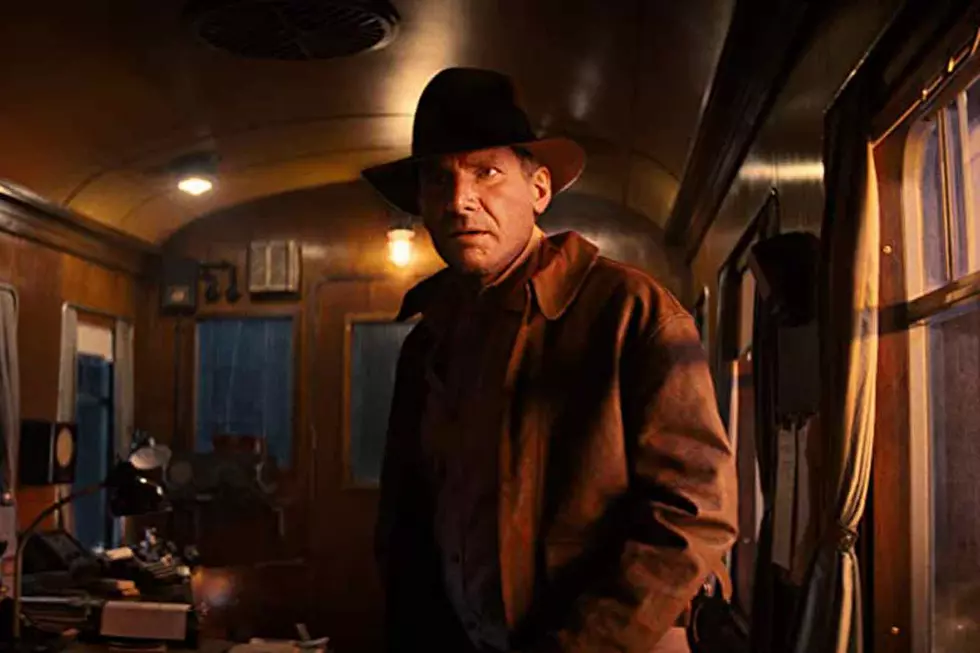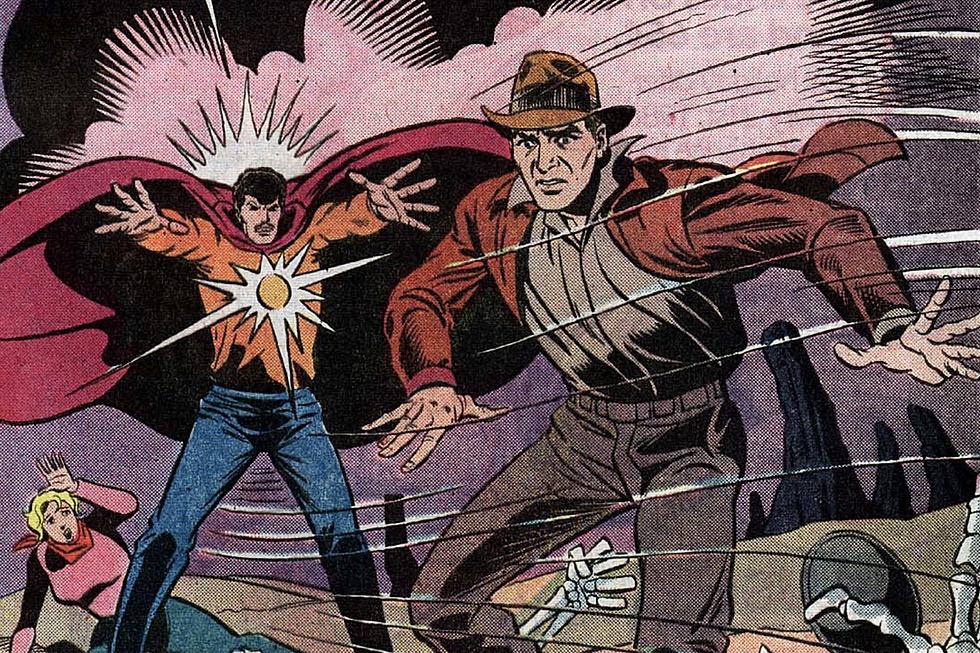
Making Movie History – A Look Back at 1981
35 years ago we were given one of the greatest horror icons of all time, one of the greatest adventure icons of all time, and believed once again that a man could fly.
Like previous posts in this series, we will include a synopsis for the movie in case you're not familiar with it (and you should be!), but unlike previous entries, we are only going with ten films instead of fifteen.
'Friday the 13th part 2'
May 1, 1981Synopsis: Two months after the events of the first film, sole survivor Alice is finally killed in her apartment by Jason. Five years later, Camp Crystal Lake is rebuilding and hosting a camp-counselor training camp. While Jason's story is told as a campfire scary story, Jason returns to the camp to continue his mother's work.
Legacy: Released just a year after the original 'Friday the 13th', it followed in its predecessor's footsteps of being panned by critics but beloved by audiences, bringing in six times its budget in its opening weekend, ultimately earning twenty times its budget. The financial success of the film put the third film on the fast track, being released the following year. The series was rebooted in 2009, but instead of doing a movie-for-movie retelling, the reboot combined aspects of this film, the original, and the third. Another Friday the 13th has been rumored for several years and as a found footage movie, though plans for that movie are continually stalled.
'Raiders of the Lost Ark'
June 12, 1981Synopsis: Archaeologist Dr. Henry Jones Jr., better known as Indiana Jones, is approached by Army Intelligence informing Dr. Jones that the Nazis have been searching for his old mentor. The Nazis are hoping to track down Abner Ravenwood since he has the headpiece to the Staff of Ra, which will allow the Nazis to find the Well of Souls and the lost Ark of the Covenant, which they believe will make their armies invincible. Dr. Jones pursues his former mentor himself, tracking down Ravenwood's daughter and Indy's former love, Marion. Together, Indy and Marion have to avoid Nazis and competing archaeologists to find the Ark first.
Legacy: Like Star Wars, George Lucas wrote Indiana Jones as an homage to classic black-and-white film serials. 'Raiders of the Lost Ark' was an instant success, both critically and financially, becoming the highest grossing film of the year by a landslide and remaining in the top 30 highest grossing films of all time. The AFI praised the film as one of the 100 greatest films in the first century of cinema, ranking it in the 60s both times they produced the list. It was followed by one prequel and two sequels, a book series, and a television series chronicling the younger years of Dr. Jones. While the fourth film, 'Indiana Jones and the Kingdom of the Crystal Skull' was labeled a massive disappointment, talk of a fifth film starring Harrison Ford continues.
'Cannonball Run'
June 19, 1981Synopsis: Based on the real life races held during the 70s, contestants drive from Conneticuict to California, using any vehicle and speed they see fit. Based on the contestants and vehicles of the 1979 race, the film focuses on Burt Reynolds and Dom DeLuise as they drive a souped-up Ambulance, mirroring the real-life team of the film's director and writer, Hal Needham and Brock Yates.
Legacy: The film is widely remembered for its all-star cast which included Reynolds and DeLuise along with Sammy Davis Jr., Dean Martin (this and its sequel mark Martin's final theatrical appearances), Jackie Chan, Roger Moore (parodying his role as James Bond), Farrah Fawcett, Jamie Farr, Terry Bradshaw, and Mel Tillis. While the film was a top 10 highest grossing of the year, the film was panned by critics and the performances were slammed, with Farrah Fawcett winning the Razzie for Worst Actress. Jackie Chan cites his experience on this movie and Hal Needham's use of a credits blooper reel as inspiring him to do the same with his films. Much of the cast returned for the sequel, 'Cannonball Run II', but no one apart from Jamie Farr returned for the third films, 'Speed Zone', each being less well-received than its predecessor.
'Superman 2'
June 19, 1981Synopsis: Responding to a bomb situation at the Eiffel Tower, Superman disposes of the bomb by throwing it into space. Unbeknownst to Superman, the explosion causes three Kryptonian criminals to be set free from the Phantom Zone. Traveling to Earth, General Zod and his followers, Ursa and Non, see the planet as easily conquerable, but have the added bonus of confronting Superman, the son of the man who imprisoned them in the Phantom Zone. While the three criminals make their way to Metropolis, Clark has to deal with his desires to be with Lois conflicting with his responsibilities as Superman.
Legacy: 'Superman II' was a financial and critical success, being a top 3 grossing film of 1981 and winning several science fiction awards. Intended to be shot simultaniously with the original film, director Richard Donner was fired from the project before completing the second film. Backlash among the cast for the firing of Donner resulted in Gene Hackman refusing to film new scenes, necessitating a sound-alike being used for voice overs, Marlon Brando's scenes being entirely cut from the film, and Margot Kidder being reduced to a glorified cameo in the third film. New director Richard Lester came in and had to reshoot much of the film in order to receive proper credit as director, changing the tone of the film to a more comedic one. Lester's changes included the much maligned scenes were Clark falls into a fireplace, thus revealing his identity to Lois, and Superman's use of holograms and a giant plastic Superman symbol during the final fight with Zod. In 2006, Richard Donner was given access to his original footage to construct his version of the film, known as "The Richard Donner Cut", which many consider to be the superior version. This version uses Donner's original plans for several scenes including Zod's release, linking it back to the ending of the original film, restores Marlon Brando's role in the film, and lessens the humor fans had complained about. Richard Lester returned for 'Superman III', which was viewed as a failure in eyes of fans and critics, focusing more on humor and Richard Pryor rather than Superman.
'For Your Eyes Only'
June 26, 1981Synopsis: Agent 007 is tasked with tracking down a stolen Automatic Targeting Attack Communicator (ATAC) system that would allow Britain's enemies to easily target the Royal Navy's fleet. While tracking down the ATAC system, Bond is aided by Melina Havelock, the daughter of two marine biologists who were murdered while looking for ATAC.
Legacy: The fifth film for Roger Moore as Bond, Moore's participation in the film was up in the air after his initial three film contract expired. Signing on a film-by-film basis, other actors were screen tested in case Moore hadn't returned. This resulted in an opening sequence with another Bond-like character, referencing Moore's uncertain return. The film was a financial success, becoming the second-highest grossing Bond film at the time. However, after a luke-warm reception to 'Moonraker' and its heavy sci-fi tone, the decision was made to make this film in the tone of the original Bond films. Reviews were mixed, with many citing this as the start of Moore appearing too old to play 007. This film also marked the directorial debut of John Glen in the Bond franchise, who would go on to direct the four subsequent films. The original Ian Fleming James Bond novels have fallen into public domain in other countries where copyright laws only extend to fifty years past the creator's death, resulting in Canadian plans for the low-budget remake of the original For Your Eyes Only short story.
'Stripes'
June 26, 1981Synopsis: After losing his job, car, apartment, and girlfriend over the course of a few hours, John Winger decides its time to get his life in order. Not seeing any other options, John and his friend Russell enlist in the Army. John and Russell are put into a platoon with other less-than-optimal recruits and have to deal with a strict, by-the-book drill sergeant, an inept commanding officer, and falling for two beautiful MPs. Their renegade attitudes and actions culminate in their graduation from basic training and an opportunity no one saw coming.
Legacy: Originally conceived as a film for Cheech and Chong, disputes with the duo's agent resulted in director Ivan Reitman looking for another starring pair. With Reitman directing, Bill Murray and Harold Ramis starring, and Ramis co-writing, this laid the initial chemistry that lead to 'Ghostbusters' four years later. Though not hitting number one at the box office, the film was a financial and critical success and stayed strong at the box office enough to end the year at the fifth most popular film.
'Escape From New York'
July 10, 1981Synopsis: In a dystopian 1997, the crime rate in America is so high that the island of Manhattan has been walled off and turned into a maximum security prison where the inmates can run free. While the President is on his way to be peace conference, Air Force One is taken over by terrorists and the President is forced to flee in an escape pod, which lands in Manhattan. Former soldier turned bank robber "Snake" Plisskin is given the chance at a full pardon if he flies into the prison and rescues the President. To make sure Snake doesn't try to fly to Canada instead, he's injected with micro explosives that will destroy his arteries if he doesn't return with the President within 22 hours.
Legacy: 'Escape From New York' is widely considered not only one of John Carpenter's best films, but one of the best, if not the best, B-movie ever made. Praised by critics, Kurt Russell's performance is regularly regarded as one of the best cinematic heroes, recognized by the AFI and other groups. The character of Snake also served as the inspiration for the character main character in the Medal Gear Solid video game franchise, referencing the names Snake and Plisskin, as well as Snake's iconic eye patch. A sequel was made 15 years later, taking Snake to Los Angeles. While the sequel performed as well at the box office as the original, the much higher budget resulted in the film being a financial failure.
'Arthur'
July 17, 1981Synopsis: Spoiled alcoholic Arthur Bach spends his vast free time drinking and annoying his valet and father-figure Hobson. Arthur is on the brink of being cut out of his family's fortune by his father unless Arthur marries a fellow aristocrat whom Arthur doesn't like. Arthur then meets Linda when she's caught shoplifting. Immediately smitten with Linda, Arthur has to decide between his growing feelings for her and his lifestyle he's grown accustomed to.
Legacy: A financial and critical success, Arthur was also a success at the Academy Awards. Nominated for Best Actor, Best Screenplay, Best Supporting Actor, and Best Original song, winning the latter two. Nearly all of the cast returned six years later for a sequel, but the response to the sequel was so negative that star Dudley Moore publicly disowned the film. A remake was made to coincide with the 30th anniversary of the film, starring Russel Brand in the titular role and gender-swapping Hobson to a maternal figure played by Helen Mirren. The remake was unfortunately a critical and financial failure.
'An American Werewolf in London'
August 21, 1981Synopsis: While backpacking across England, college friends David and Jack are attacked by a large wolf, with only David surviving. As David recouperates and starts a relationship with his nurse Alex, Jack begins appearing to David in the form or a constantly decaying corpse, explaining to David that they were attacked by a werewolf and David will turn into one too at the next full moon.
Legacy: After working with the pair on 'Blues Brothers', writer/director Jon Landis wanted to cast Dan Aykroyd and Jim Belushi as David and Jack, respectively. A financial and critical success, lauded for the blend of comedy and horror, it was Rick Baker's make-up work that received the greatest recognition. Especially praised for his work on the decaying Jack and David's werewolf transformation, widely considered the greatest live action werewolf transformation in film, Baker won the Academy Award for Best Makeup that year. A sequel came out in 1997, following the daughter of David and Alex as she lives in Paris.
'Halloween 2'
October 30, 1981Synopsis: Picking up immediately after the events of the first film, Laurie Strode is taken to the hospital after being attacked by Michael Myers, who fled the scene after being shot by Dr. Loomis. While Laurie is treated at the hospital, Dr. Loomis continues his search for Michael, who has made his way to the hospital to finish off Laurie. In his search, Dr. Loomis discovers Laurie's true identity as Michael's little sister. Realizing she's been his target all along, Dr. Loomis must get back to the hospital before its too late.
Legacy: Originally meant to be the final part of the Michael Myers story, the film ended on a fairly definitive note. The film was a success, but critics and fans felt it didn't do enough to follow in the impressive footsteps of the first. From this point on, the Halloween franchise was meant to feature a new, self-contained story with each installment, beginning with 'Halloween 3: Season of the Witch'. Fans were upset about the lack of Michael Myers and the focus of the franchise was shifted back to Michael for three more films. Jamie Lee Curtis returned for 'Halloween: H20', a film that follows Laurie Myers as an adult and disregards the events of parts four through six. Curtis came back for 'Halloween: Resurrection', only to have her character killed off to prevent it from being used in future installments. Rob Zombie took over the franchise and rebooted it in his dark and gritty style. His reboot was a massive hit both financially and critically, but his follow-up was slammed by fan and critics for delving too much into the history of Michael and incorporating confusing elements into his backstory.
More From 92.9 NiN
![Did a UFO Fly Over Wichita Falls, Texas on Friday the 13th? [VIDEO]](http://townsquare.media/site/175/files/2023/10/attachment-GettyImages-665946.jpg?w=980&q=75)








